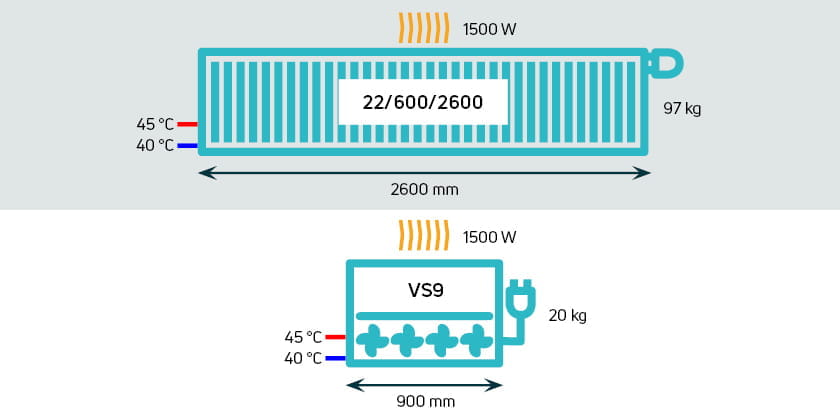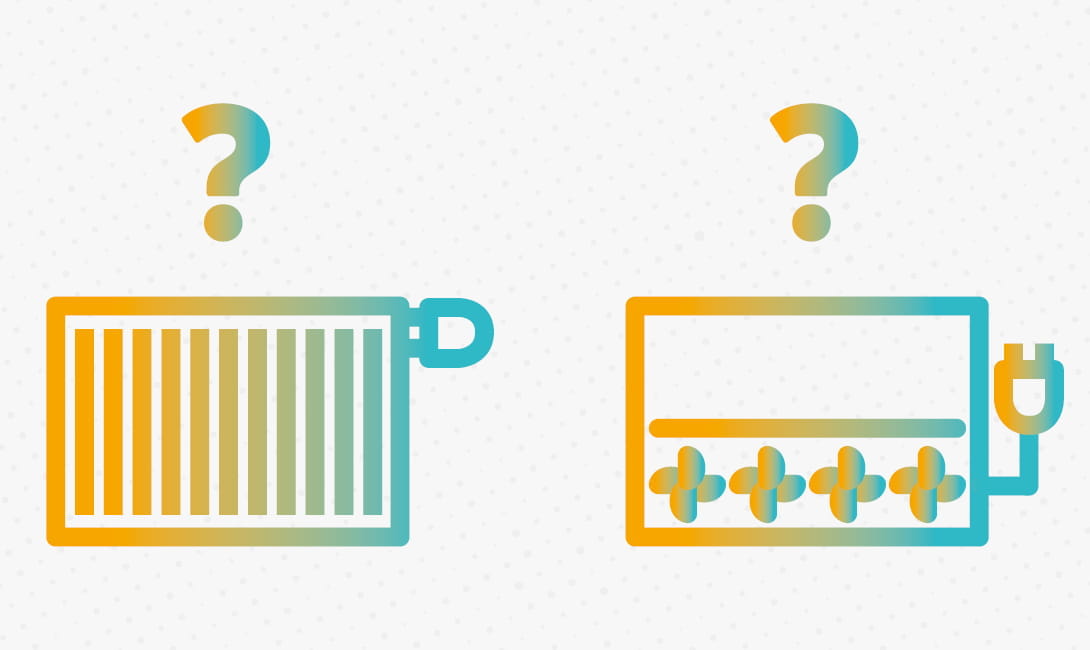- Work smarter
- Energy saving
- Product info
- Radiators
Radiators for a low temperature heating system: panel radiators vs. fan convectors
What is a low temperature heating system?
A traditional heating system that is getting on in years and is usually found in poorly insulated buildings, generally has a supply temperature of about 70 to 80°C. In a low temperature heating system, installed in well-insulated buildings, this temperature is anywhere between 35 and 55°C. That means that both the supply temperature of the central heating water and the surface temperature of the heat emitter are significantly lower.
Higher levels of insulation mean our buildings can be heated more easily as they reduce both the heating load and the heat loss. Thanks to the lower heating load, the desired room temperature can be reached with lower system temperatures. Moreover, the ever greater responsiveness of modern radiator systems allows for any heat gains to be better utilised. A low temperature heating system thus requires less energy, which means it’s more eco-friendly and weighs less heavily on the budget than an old central heating system.
A low temperature heating system with modern radiators
When switching from an old heating system to a low temperature heating system, the heating load must be recalculated for each room. Taking into account the degree of insulation and the newly calculated heat load, it’s possible to determine the lowest possible flow temperature. If the calculated temperature exceeds 40°C, modern panel radiators are a great match.
In case the heating load remains unchanged as a lack of insulation measures, the installation of a low temperature heating system requires a larger dimensioning of the radiators to maximise heat transfer. Luckily, technical developments and design measures such as the optimisation of the shape and arrangement of the convector plates have ensured that modern radiators are much more efficient. This allows them to provide the same heat output as old radiators of the same size with lower system temperatures when installed in a properly insulated building.
Additionally, modern radiators incorporate more efficient control technology which allows for precise temperature control. A properly sized radiator combined with a modern thermostatic control system guarantees efficient operation.
Easily calculate the heating load
A low temperature heating system with fan convectors
If the calculated design temperature drops below 40°C, fan convectors are more suitable. In a low temperature heating system with flow temperatures below 40°C natural convection doesn’t occur, creating a need for fan support. The lower flow temperature means the temperature differences between the radiator and the warming air lead to lower buoyancy forces. In such cases, low temperature radiators with integrated fans, such as the Ulow E2, or fan convectors, such as the iVector S2, are a better fit because their integrated fans support the convective heat dissipation and increase the total heat output.
For example, in a low temperature heating system with flow temperatures of 45/40/20°C, the iVector S2 VS9 can easily provide the required heat output. It can reach up to 1500W at medium fan speed. This fan convector has a depth of 13 cm, is 90 cm long, 60 cm high, and weighs 20 kg. To reach the same heat output with a panel radiator, you would need, for example, a 22/600 x 2600 model, which has a depth of 11 cm, is 2,6 m long, 60 cm high and weighs as much as 97,5 kg. The big difference in length and weight, means you not only need significantly more wall space, but also much more material resources for the same heat output. Additionally, the iVector S2 can be used for heating as well as cooling, as opposed to a regular panel radiator.

Turning it the other way around, we can take a panel radiator like the 22/600 x 900 model, which is still about 50 kg but has similar dimensions to the iVector S2 VS9. The problem is, though, that if you want the same heat output (+/- 1500 W), the water temperature must be 75/65/20°C. This not only means that it’s no longer a low temperature heating system, it also requires the heat generator to heat up the water 30°C more than when the fan convector is used, which naturally drives up the daily energy consumption.
Find out more about the iVector S2
A fitting solution for every low temperature heating system
The example above clearly demonstrates the important correlation between the level of thermal insulation, the required heat load and corresponding flow temperature on the one hand and the different elements of a heating system on the other hand. Just because of this strong connection, it’s important that all elements are aligned. As indoor climate solutions specialist, we understand this better than anyone else. That’s why we support our customers with a wide range of products and services so that it’s easy to find that perfect match for a sustainable and comfortable indoor climate.
If you’re not sure about the right panel radiator or fan convector for your low temperature heating system, don’t hesitate to contact us. Our indoor climate comfort specialist are happy to help with tailored advice.

